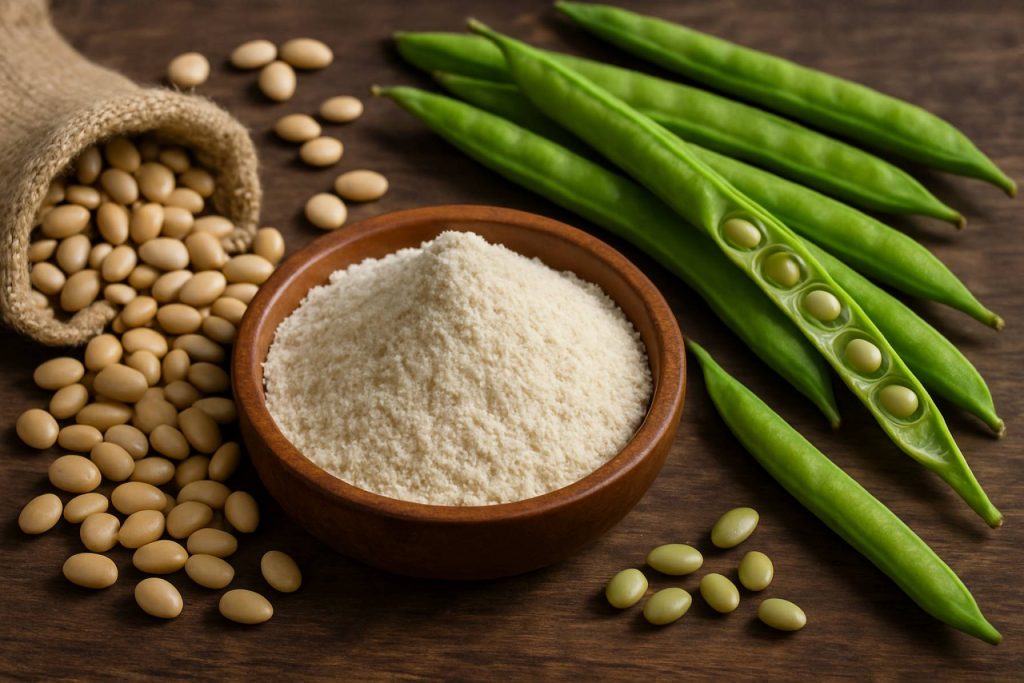
Guar Gum Production and Applications: From Crop to Critical Ingredient. Discover How This Natural Polymer is Shaping Food, Pharma, and Oilfield Industries Worldwide. (2025)
- Introduction to Guar Gum: Origins and Global Significance
- Botanical and Agronomic Aspects of Guar Cultivation
- Extraction and Processing Technologies for Guar Gum
- Key Industrial Applications: Food, Pharmaceuticals, and Beyond
- Guar Gum in Oil & Gas: Hydraulic Fracturing and Drilling Fluids
- Quality Standards and Regulatory Frameworks
- Major Producers and Global Supply Chain Dynamics
- Market Trends, Demand Drivers, and Forecasts (2024–2030)
- Technological Innovations and Sustainability Initiatives
- Future Outlook: Growth Potential and Emerging Applications
- Sources & References
Introduction to Guar Gum: Origins and Global Significance
Guar gum, a natural polysaccharide derived from the seeds of the guar plant (Cyamopsis tetragonoloba), has become a vital industrial hydrocolloid with diverse applications worldwide. The origins of guar cultivation trace back to the arid and semi-arid regions of India and Pakistan, where the crop is well-adapted to challenging climatic conditions. Today, India stands as the leading producer, accounting for approximately 80% of global guar seed output, with significant cultivation also occurring in Pakistan and, to a lesser extent, the United States, Australia, and parts of Africa.
The production of guar gum involves harvesting mature guar pods, extracting the seeds, and processing them to separate the endosperm, which is then milled into a fine powder. This powder, known as guar gum, is prized for its exceptional thickening, stabilizing, and emulsifying properties. The unique molecular structure of guar gum, primarily composed of galactomannan, enables it to hydrate rapidly in cold water and form highly viscous solutions even at low concentrations.
Guar gum’s versatility underpins its global significance. In the food industry, it is widely used as a stabilizer and thickener in products such as ice cream, dairy items, sauces, and gluten-free baked goods. Its ability to improve texture and shelf life has made it a staple additive, recognized as safe by regulatory authorities such as the U.S. Food and Drug Administration and the European Food Safety Authority. Beyond food, guar gum plays a crucial role in the oil and gas sector, particularly in hydraulic fracturing (fracking), where it serves as a gelling agent to facilitate the extraction of hydrocarbons. This application has driven significant demand, especially in North America.
Other notable uses include pharmaceuticals, where guar gum acts as a binder and disintegrant in tablet formulations, and cosmetics, where it functions as a thickener in lotions and creams. The textile, paper, and mining industries also utilize guar gum for its water retention and binding capabilities. The global trade and economic importance of guar gum are reflected in its status as a key export commodity for producing countries, with international standards and quality controls overseen by organizations such as the Food and Agriculture Organization of the United Nations.
As industries continue to seek sustainable and plant-based ingredients, guar gum’s role is expected to expand, reinforcing its position as a critical agricultural and industrial resource in 2025 and beyond.
Botanical and Agronomic Aspects of Guar Cultivation
Guar gum, a galactomannan polysaccharide, is derived from the seeds of the guar plant (Cyamopsis tetragonoloba), a drought-tolerant legume primarily cultivated in arid and semi-arid regions. The botanical characteristics of guar make it particularly suited to challenging agro-climatic conditions. The plant is an annual herb, typically reaching heights of 1–2 meters, with trifoliate leaves and clusters of pale purple or white flowers. Its pods, each containing 5–12 seeds, are the primary source of guar gum. The seeds consist of three main parts: the hull, the endosperm (rich in galactomannan), and the germ. The endosperm is mechanically separated and processed to extract guar gum powder, which is valued for its thickening and stabilizing properties.
Agronomically, guar is notable for its adaptability to marginal soils and its ability to fix atmospheric nitrogen, thereby improving soil fertility. It is typically sown at the onset of the monsoon (June–July) and harvested after 3–4 months. Optimal growth requires well-drained sandy loam soils and minimal rainfall, making it a preferred crop in regions with limited water resources. India is the world’s leading producer, accounting for approximately 80% of global guar seed output, with major cultivation concentrated in Rajasthan, Gujarat, and Haryana. Other significant producers include Pakistan, the United States, and Sudan. The crop’s resilience to drought and its short growing season make it an important rotation crop, contributing to sustainable agricultural practices.
Guar cultivation is supported by research and extension services from organizations such as the Indian Council of Agricultural Research (ICAR), which develops improved guar varieties and disseminates best agronomic practices. These efforts focus on enhancing yield, disease resistance, and gum content, as well as promoting sustainable water and soil management. The United States Department of Agriculture (USDA) also provides agronomic guidance for guar cultivation in the southwestern United States, where the crop is grown under irrigation and dryland conditions.
The botanical and agronomic attributes of guar underpin its significance as a commercial crop for guar gum production. Its ability to thrive in resource-limited environments, improve soil health, and provide a valuable industrial raw material highlights the importance of continued research and development in guar cultivation. These efforts ensure a stable supply of guar gum for diverse applications, ranging from food and pharmaceuticals to oil and gas industries.
Extraction and Processing Technologies for Guar Gum
Guar gum, a galactomannan polysaccharide derived from the seeds of the guar plant (Cyamopsis tetragonoloba), is valued for its thickening, stabilizing, and emulsifying properties. The extraction and processing of guar gum involve a series of mechanical and chemical steps designed to maximize yield and purity while preserving the functional characteristics of the gum. The process begins with the harvesting and cleaning of guar seeds, primarily cultivated in India and Pakistan, which together account for the majority of global production.
The cleaned seeds are first dehusked to remove the outer shell, followed by splitting to separate the endosperm from the germ. The endosperm, which contains the highest concentration of galactomannan, is then subjected to grinding and screening to produce guar splits. These splits are further processed through a series of mechanical and pneumatic systems to achieve the desired particle size. The final step involves hydration, where the splits are soaked in water to facilitate the release of guar gum, followed by wet milling and filtration to remove impurities.
After extraction, the guar gum slurry is dried using either drum dryers or flash dryers, depending on the desired viscosity and application. The dried product is then milled into a fine powder and may undergo further purification steps, such as sieving and chemical treatment, to enhance its quality for specific industrial uses. The entire process is designed to minimize contamination and ensure compliance with food safety and quality standards, as guar gum is widely used in food, pharmaceutical, and industrial applications.
Advancements in extraction and processing technologies have focused on improving efficiency, reducing energy consumption, and enhancing product consistency. For example, some manufacturers have adopted enzymatic treatments to increase yield and reduce the need for harsh chemicals. Automation and process control systems are increasingly used to monitor critical parameters such as temperature, moisture content, and particle size distribution, ensuring a uniform product that meets the stringent requirements of end users in sectors such as food, oil and gas, and cosmetics.
- International Crops Research Institute for the Semi-Arid Tropics (ICRISAT) is a leading research organization involved in the development of improved guar varieties and sustainable processing methods.
- Food Safety and Standards Authority of India (FSSAI) regulates the quality and safety of guar gum used in food applications within India, the world’s largest producer.
- Food and Agriculture Organization of the United Nations (FAO) provides global data and technical guidance on guar cultivation and processing.
Key Industrial Applications: Food, Pharmaceuticals, and Beyond
Guar gum, a natural polysaccharide derived from the seeds of the guar plant (Cyamopsis tetragonoloba), is a versatile hydrocolloid widely utilized across multiple industries due to its thickening, stabilizing, and emulsifying properties. Its production is concentrated primarily in India and Pakistan, where the climate is suitable for guar cultivation. The manufacturing process involves dehusking, milling, and screening the guar seeds to obtain the refined guar gum powder, which is then distributed globally for various industrial applications.
In the food industry, guar gum is valued as a food additive (E412) for its ability to improve texture, viscosity, and shelf life. It is commonly used in baked goods, dairy products, sauces, dressings, and beverages. Its high water-binding capacity makes it an effective thickener in gluten-free recipes and a stabilizer in ice creams and yogurts, preventing ice crystal formation and phase separation. Regulatory authorities such as the U.S. Food and Drug Administration and the European Food Safety Authority recognize guar gum as safe for consumption within specified limits.
In the pharmaceutical sector, guar gum serves as a binder, disintegrant, and controlled-release agent in tablet formulations. Its biocompatibility and non-toxicity make it suitable for use in oral drug delivery systems, where it can modulate the release of active pharmaceutical ingredients. Additionally, guar gum is employed in the formulation of suspensions, emulsions, and topical products due to its stabilizing and viscosity-enhancing effects. The United States Pharmacopeia includes guar gum in its compendium, underscoring its importance in pharmaceutical manufacturing.
Beyond food and pharmaceuticals, guar gum finds significant application in the oil and gas industry, particularly in hydraulic fracturing (fracking) fluids, where it acts as a gelling agent to transport proppants into rock formations. Its use enhances the efficiency of oil and gas extraction by improving fluid viscosity and reducing friction. The American Petroleum Institute sets standards for guar gum quality in drilling and fracturing operations. Other industrial uses include paper manufacturing, textile printing, cosmetics, and personal care products, where guar gum functions as a thickener, stabilizer, or conditioning agent.
- Food: thickener, stabilizer, emulsifier (ice cream, sauces, gluten-free products)
- Pharmaceuticals: binder, controlled-release agent, suspension stabilizer
- Oil & Gas: gelling agent in hydraulic fracturing fluids
- Other: paper, textiles, cosmetics, personal care
The broad spectrum of guar gum’s industrial applications is a testament to its functional versatility and economic significance, with ongoing research exploring new uses and improved processing techniques to meet evolving industry demands.
Guar Gum in Oil & Gas: Hydraulic Fracturing and Drilling Fluids
Guar gum, a natural polysaccharide derived from the seeds of the guar plant (Cyamopsis tetragonoloba), plays a pivotal role in the oil and gas industry, particularly in hydraulic fracturing (fracking) and drilling fluid formulations. The production of guar gum begins with the cultivation of guar, predominantly in India and Pakistan, where the climate and soil conditions are optimal for its growth. After harvesting, the seeds are processed to extract the endosperm, which is then milled and refined to produce guar gum powder of varying viscosities and purities.
In hydraulic fracturing, guar gum serves as a key gelling agent in fracturing fluids. Its primary function is to increase the viscosity of water-based fluids, enabling the efficient transport of proppants—such as sand—into subterranean rock formations. The high viscosity imparted by guar gum ensures that proppants remain suspended during injection, maximizing the creation and maintenance of fractures in the reservoir rock. This process enhances the extraction of oil and natural gas by improving the permeability of the formation. Guar gum’s ability to hydrate rapidly and form stable gels under a range of temperatures and pH conditions makes it especially valuable in the demanding environments encountered during fracking operations.
Beyond hydraulic fracturing, guar gum is also widely used in drilling fluids. In this context, it acts as a viscosifier and water loss control agent. By increasing the viscosity of drilling muds, guar gum helps to carry drill cuttings to the surface, lubricate the drill bit, and stabilize the borehole walls. Its water retention properties minimize fluid loss into permeable formations, reducing the risk of wellbore instability and formation damage. The biodegradability and non-toxic nature of guar gum further contribute to its appeal as an environmentally responsible additive in oilfield applications.
The global supply chain for guar gum is supported by major producers and exporters, with India accounting for approximately 80% of the world’s production. The Agricultural and Processed Food Products Export Development Authority (APEDA) of India plays a significant role in regulating and promoting guar gum exports, ensuring quality standards and supporting market access. Additionally, industry organizations such as the Indian Oil & Gas Regulatory Board oversee the application of guar gum in oilfield operations, emphasizing safety and performance standards.
As unconventional oil and gas extraction continues to expand globally, the demand for guar gum in hydraulic fracturing and drilling fluids is expected to remain robust. Ongoing research focuses on optimizing guar gum derivatives and blends to further enhance their performance under extreme downhole conditions, ensuring the continued relevance of this natural polymer in the evolving energy sector.
Quality Standards and Regulatory Frameworks
Guar gum, a natural polysaccharide derived from the seeds of the guar plant (Cyamopsis tetragonoloba), is widely used in food, pharmaceutical, textile, paper, and oil industries. Ensuring the quality and safety of guar gum is critical, given its diverse applications, especially in food and pharmaceuticals. The production and application of guar gum are governed by a comprehensive set of quality standards and regulatory frameworks established by national and international authorities.
Globally, the Food and Agriculture Organization of the United Nations (FAO) and the World Health Organization (WHO) have set specifications for food additives, including guar gum, through the Codex Alimentarius Commission. The Codex standard (INS 412) defines purity criteria, permissible levels of contaminants, and labeling requirements for guar gum used as a food additive. These standards are widely adopted by national regulatory agencies to ensure product safety and facilitate international trade.
In the United States, the U.S. Food and Drug Administration (FDA) classifies guar gum as Generally Recognized as Safe (GRAS) for use in food, provided it meets specific purity and quality parameters. The FDA’s Code of Federal Regulations (21 CFR 184.1339) outlines the acceptable uses, maximum levels, and labeling requirements for guar gum in food products. For pharmaceutical applications, guar gum must comply with the monographs published in the United States Pharmacopeia (USP), which specify tests for identity, purity, viscosity, and microbial limits.
In the European Union, guar gum is regulated as a food additive (E412) under Regulation (EC) No 1333/2008. The European Food Safety Authority (EFSA) conducts risk assessments and provides scientific opinions on its safety, while the European Pharmacopoeia sets standards for pharmaceutical-grade guar gum. The EU also enforces strict limits on contaminants such as dioxins and pentachlorophenol, following incidents of contamination in the past.
India, as the world’s largest producer and exporter of guar gum, has established its own quality standards through the Food Safety and Standards Authority of India (FSSAI) and the Bureau of Indian Standards (BIS). These agencies set specifications for food-grade and industrial-grade guar gum, including parameters for moisture, ash content, viscosity, and microbial safety.
Compliance with these regulatory frameworks is essential for manufacturers to access global markets and ensure consumer safety. Regular audits, third-party certifications, and adherence to Good Manufacturing Practices (GMP) are integral to maintaining the quality and integrity of guar gum throughout its production and application lifecycle.
Major Producers and Global Supply Chain Dynamics
Guar gum, a natural polysaccharide derived from the seeds of the guar plant (Cyamopsis tetragonoloba), is a critical ingredient in various industries, including food, pharmaceuticals, oil and gas, and textiles. The global supply chain for guar gum is shaped by a concentrated production base, complex trade flows, and evolving demand patterns.
India is by far the world’s largest producer and exporter of guar gum, accounting for approximately 80% of global production. The states of Rajasthan, Haryana, and Gujarat are the primary cultivation zones, benefiting from arid climates suitable for guar farming. The Agricultural and Processed Food Products Export Development Authority (APEDA), an official body under the Government of India, plays a pivotal role in regulating and promoting guar gum exports. India’s dominance is supported by a well-established network of processors and exporters, who transform raw guar seeds into refined splits and powder for international markets.
Pakistan is the second-largest producer, with significant cultivation in Sindh and Punjab provinces. While its output is much smaller than India’s, Pakistan’s guar gum industry is growing, supported by both domestic consumption and exports. The Government of Pakistan has identified guar as a strategic crop, encouraging research and development to improve yields and processing efficiency.
Other countries, such as the United States, Sudan, and South Africa, contribute marginally to global guar gum production. In the U.S., guar is cultivated primarily in Texas and Oklahoma, with research support from institutions like the United States Department of Agriculture (USDA). However, these regions face challenges related to climate variability and competition from other crops.
The global supply chain is highly sensitive to fluctuations in Indian monsoon patterns, as well as to shifts in demand from major end-use sectors. The oil and gas industry, particularly in North America, is a significant consumer of guar gum for hydraulic fracturing fluids. This creates volatility in prices and supply, as seen during periods of high shale gas activity. Food and pharmaceutical industries worldwide also rely on guar gum for its thickening, stabilizing, and emulsifying properties, making it a staple in processed foods, gluten-free products, and drug formulations.
International trade in guar gum is facilitated by established export channels, with India shipping to the United States, European Union, China, and other regions. Quality standards and regulatory compliance, overseen by organizations such as U.S. Food and Drug Administration (FDA) and European Food Safety Authority (EFSA), are critical in maintaining market access and consumer safety.
Market Trends, Demand Drivers, and Forecasts (2024–2030)
The global guar gum market is experiencing dynamic shifts, driven by evolving demand patterns, technological advancements, and changing regulatory landscapes. Guar gum, a natural polysaccharide extracted from guar beans, is widely utilized across industries such as food and beverages, oil and gas, pharmaceuticals, cosmetics, and textiles. The period from 2024 to 2030 is expected to witness significant growth in both production and application diversity, underpinned by several key market trends and demand drivers.
One of the primary demand drivers is the food and beverage sector, where guar gum serves as a thickener, stabilizer, and emulsifier. The increasing consumer preference for gluten-free and clean-label products has bolstered its use in bakery, dairy, and processed foods. Regulatory approvals for guar gum as a food additive by authorities such as the U.S. Food and Drug Administration and the European Food Safety Authority further support its widespread adoption.
The oil and gas industry remains a significant consumer of guar gum, particularly in hydraulic fracturing (fracking) operations, where it is used as a gelling agent to enhance the viscosity of fracturing fluids. Fluctuations in crude oil prices and exploration activities directly impact guar gum demand in this sector. However, ongoing research into alternative fracking fluids and environmental concerns may moderate growth rates in this application.
Emerging applications in pharmaceuticals and personal care are also contributing to market expansion. Guar gum’s biocompatibility and non-toxic nature make it suitable for drug delivery systems, wound care, and cosmetic formulations. The growing focus on natural and sustainable ingredients in these industries is expected to further stimulate demand.
India remains the world’s leading producer and exporter of guar gum, accounting for over 80% of global supply. The Agricultural and Processed Food Products Export Development Authority (APEDA) plays a pivotal role in promoting Indian guar gum exports and ensuring quality standards. Production trends are influenced by monsoon patterns, crop acreage, and government support for guar cultivation.
Looking ahead to 2030, the guar gum market is forecasted to grow steadily, with Asia-Pacific and North America as key regions. Market expansion will be shaped by innovations in processing technologies, increased adoption in emerging economies, and the development of value-added guar derivatives. Sustainability initiatives and traceability requirements are likely to become more prominent, influencing both production practices and consumer preferences.
Technological Innovations and Sustainability Initiatives
Technological innovations and sustainability initiatives are increasingly shaping the landscape of guar gum production and its diverse applications. Traditionally, guar gum is derived from the endosperm of guar beans (Cyamopsis tetragonoloba), a leguminous crop primarily cultivated in India and Pakistan. Recent advancements in agricultural practices, processing technologies, and environmental stewardship are driving the industry toward greater efficiency and reduced ecological impact.
On the agricultural front, precision farming techniques—such as drip irrigation, soil health monitoring, and the use of biofertilizers—are being adopted to optimize guar crop yields while minimizing water and chemical inputs. These methods not only enhance productivity but also contribute to soil conservation and reduced greenhouse gas emissions. Organizations like the Food and Agriculture Organization of the United Nations promote sustainable legume cultivation practices, which are increasingly being integrated into guar farming systems.
In processing, technological innovations focus on energy-efficient milling, improved separation of gum from husk, and the reduction of waste. Modern guar gum plants are implementing closed-loop water systems and advanced filtration technologies to minimize water consumption and effluent discharge. Automation and real-time quality monitoring are also being introduced to ensure consistent product quality and traceability throughout the supply chain. Companies such as Hindustan Unilever and Tata Chemicals, both active in the broader food and ingredients sector, are investing in sustainable sourcing and processing initiatives for plant-based hydrocolloids, including guar gum.
Sustainability initiatives extend to the application side as well. In the food industry, guar gum is valued for its natural origin and multifunctionality as a thickener, stabilizer, and emulsifier, supporting the development of clean-label and plant-based products. The United States Department of Agriculture recognizes guar gum as a safe food additive, and its use aligns with consumer demand for sustainable and minimally processed ingredients. In oil and gas, where guar gum is used in hydraulic fracturing fluids, research is underway to develop biodegradable and more environmentally benign formulations, reducing the ecological footprint of extraction activities.
Looking ahead to 2025, the guar gum industry is expected to further embrace circular economy principles, such as valorizing by-products for animal feed or bioenergy, and collaborating with international organizations to set sustainability benchmarks. These efforts underscore the sector’s commitment to technological progress and environmental responsibility, ensuring guar gum remains a vital and sustainable resource across multiple industries.
Future Outlook: Growth Potential and Emerging Applications
The future outlook for guar gum production and its applications in 2025 is shaped by evolving industrial demands, technological advancements, and sustainability considerations. Guar gum, a natural polysaccharide derived from the seeds of the guar plant (Cyamopsis tetragonoloba), continues to be a critical ingredient across multiple sectors, including food, pharmaceuticals, oil and gas, and personal care. As global industries seek more sustainable and functional ingredients, guar gum’s versatility positions it for continued growth and innovation.
In the food industry, guar gum’s role as a thickener, stabilizer, and emulsifier is expected to expand, particularly in the development of plant-based and gluten-free products. The increasing consumer preference for clean-label and natural additives is likely to drive further adoption. Regulatory authorities such as the U.S. Food and Drug Administration and the European Food Safety Authority recognize guar gum as a safe food additive, supporting its continued use and market expansion.
Emerging applications in the pharmaceutical and nutraceutical sectors are also anticipated to contribute to growth. Guar gum’s biocompatibility and non-toxic nature make it suitable for drug delivery systems, controlled release formulations, and as a dietary fiber supplement. Research into guar gum-based hydrogels and nanocomposites is opening new avenues for medical and biomedical uses, including wound care and tissue engineering.
The oil and gas industry remains a significant consumer of guar gum, particularly for hydraulic fracturing (fracking) fluids, where it serves as a viscosifier. While market volatility and the shift toward renewable energy sources may influence demand, ongoing exploration and enhanced oil recovery techniques are expected to sustain guar gum’s relevance in this sector. Major producers and exporters, such as those represented by the Agricultural and Processed Food Products Export Development Authority (APEDA) of India, are investing in improved processing technologies and quality standards to meet global requirements.
Looking ahead, sustainability and supply chain resilience are key focus areas. Efforts to optimize guar cultivation, improve seed varieties, and implement environmentally friendly processing methods are underway. Organizations like the International Crops Research Institute for the Semi-Arid Tropics (ICRISAT) are actively involved in research to enhance guar crop yields and adaptability, which will be crucial for meeting future demand.
In summary, the outlook for guar gum production and applications in 2025 is positive, with growth potential driven by innovation, expanding end-use industries, and a global shift toward sustainable, plant-based ingredients.
Sources & References
- European Food Safety Authority
- Food and Agriculture Organization of the United Nations
- United States Department of Agriculture
- International Crops Research Institute for the Semi-Arid Tropics (ICRISAT)
- Food Safety and Standards Authority of India (FSSAI)
- United States Pharmacopeia
- American Petroleum Institute
- Agricultural and Processed Food Products Export Development Authority (APEDA)
- World Health Organization
- Agricultural and Processed Food Products Export Development Authority
- Tata Chemicals



